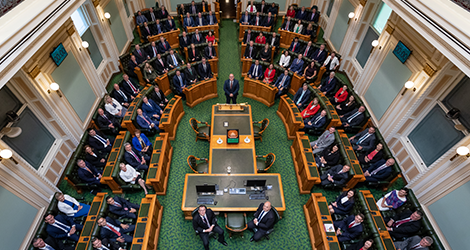Note: Most information in this media release is for a time period before the 2019-20 summer bushfires and the COVID–19 pandemic.
Fewer Australians are smoking daily than ever before and more Australians are giving up alcohol, according to survey results released by the Australian Institute of Health and Welfare (AIHW).
The results from the National Drug Strategy Household Survey 2019 also show that there has been a drop in the non-medical use of pain-killers and opioids but the use of some illicit drugs has increased.
Smoking
The three-yearly survey of more than 22,000 people aged 14 and over included questions about tobacco use, which is the leading cause of preventable disease and death in Australia.
‘Smoking rates have more than halved since 1991 when almost one quarter (24%) of Australians were daily smokers,’ said AIHW spokesperson Dr. Gabrielle Phillips.
‘The daily smoking rate was 12.2% in 2016 and 11% in 2019. More smokers said the cost of smoking was motivating them to quit or cut back—58% in 2019 compared with 52% in 2016.’
Alcohol
Alcohol remains the most commonly used drug in Australia, with about 3 in 4 Australians reporting they consumed alcohol in the previous 12 months. The proportion of people drinking at risky levels on a single occasion (at least monthly) (25%) or at levels that put them at risk of harm over their lifetime (16.8%) has been stable since 2016.
“The proportion of ex-drinkers rose from 7.6% to 8.9% between 2016 and 2019. There was also a rise in the number of people cutting back on alcohol, with 31% of people saying they had reduced the number of alcoholic drinks they consumed at any one time, up from 28% in 2016,’ Dr. Phillips said.
As noted above, the data in the report predates the COVID-19 pandemic. The AIHW funded and collaborated with the Australian National University on research in May which found that 27% of Australians who consume alcohol reported drinking less since the spread of COVID-19, while 20% reported drinking more.
Illicit drugs
The reclassification of medications containing codeine in 2018 to make them available only by prescription appears to be largely responsible for a decline in the non-medical use of pharmaceuticals.
‘The proportion of people using codeine for non-medical purposes has halved since 2016, from 3.0% to 1.5% in 2019,’ Dr. Phillips said.
“Overall, the use of pharmaceuticals for non-medical purposes in the previous 12 months dropped from 4.8% to 4.2%.’
The proportion of people who reported recently using some illicit drugs within the past 12 months increased between 2016 and 2019 but was at a similar level to 2001. From 2016 to 2019:
- Marijuana/cannabis, increased from 10.4% to 11.6%
- Ecstasy, increased from 2.2% to 3.0%
- Cocaine, increased from 2.5% to 4.2%
- Hallucinogens, increased from 1.0% to 1.6%
- Inhalants, increased from 1.0% to 1.4%
- Ketamine, increased from 0.4% to 0.9%
‘In 2019, more than 43%, or 9 million, Australians aged 14 and over had illicitly used a drug at some point in their lifetime and 3.4 million (or 16.4%) had used one in the past 12 months,’ Dr. Phillips said.
Age groups
Today’s 14–29 year olds are less likely to smoke, drink alcohol or consume illicit drugs than previous generations.
In 2019, two-thirds of 14–17 year olds had never consumed a full standard drink—more than double the proportion in 2001. In 2019, 22% of 20–29 year olds abstained from alcohol, up from 8.9% in 2001.
‘In 2001, 38% of 14–19 year olds had used an illicit drug at some point in their lives, but by 2019, this was 22%,’ Dr. Phillips said.
‘People aged in their 40s were the most likely to have used an illicit drug their lifetime (55% in 2019).’
Australians in their 40s (15.8%) and 50s (15.9%) were most likely to smoke daily in 2019. Older people were also the most likely to drink alcohol daily in 2019, with the highest proportion seen among people aged over 70 (12.6%).
Aboriginal and Torres Strait Islander Australians
Since 2010, risky alcohol consumption and smoking by Aboriginal and Torres Strait Islander Australians has generally declined while illicit drug use has remained stable.
‘Indigenous Australians are slightly more likely to abstain from alcohol than non-Indigenous Australians, but among those who do consume alcohol, a higher proportion drink at risky levels,’ Dr. Phillips said.
‘However, the gap between Indigenous Australians and non-Indigenous Australians exceeding lifetime alcohol consumption risk guidelines has narrowed, from 1.5 times as high in 2010 to 1.2 in 2019.’
The proportion of Indigenous Australians aged 14 and over who smoked daily fell from 35% in 2010 to 25% in 2019.
Between 2016 and 2019, there was little change in the recent use of cannabis (from 19.4% to 16.0%) and pharmaceuticals used for non-medical purposes (10.6% to 7.0%). The results for illicit drug use must be treated with caution due to the relatively small number of Aboriginal and Torres Strait Islander people surveyed.
Gay, lesbian and bisexual Australians
Daily smoking and risky drinking rates by Australians who identify as gay, lesbian and bisexual are down since 2010 but use of an illicit drug in the previous 12 months has remained similar over the past decade.
‘Between 2010 and 2019, the daily smoking rate for gay, lesbian and bisexual Australians decreased from 28% to 16%, and the proportion drinking beyond the recommended guidelines, and consuming more than 4 standard drinks on one occasion at least once a month, fell from 45% to 38%,’ Dr. Phillips said.
Use of an illicit drug in the previous 12 months was similar over the same period, 36% in 2010 and 40% in 2019.
Over the most recent 3 year period, the non-medical use of pharmaceuticals fell from 12.0% in 2016 to 7.5% in 2019, mainly due to decreases in the use of pain-killers and opioids (down from 7.6% to 4.3%).
The 2019 survey did not capture information on Australians who identify as transgender or intersex, however the AIHW will look to include all LGBTIQ+ people in future research.
The survey results also include information on public attitudes towards, and perceptions of, alcohol, tobacco and illicit drugs.








